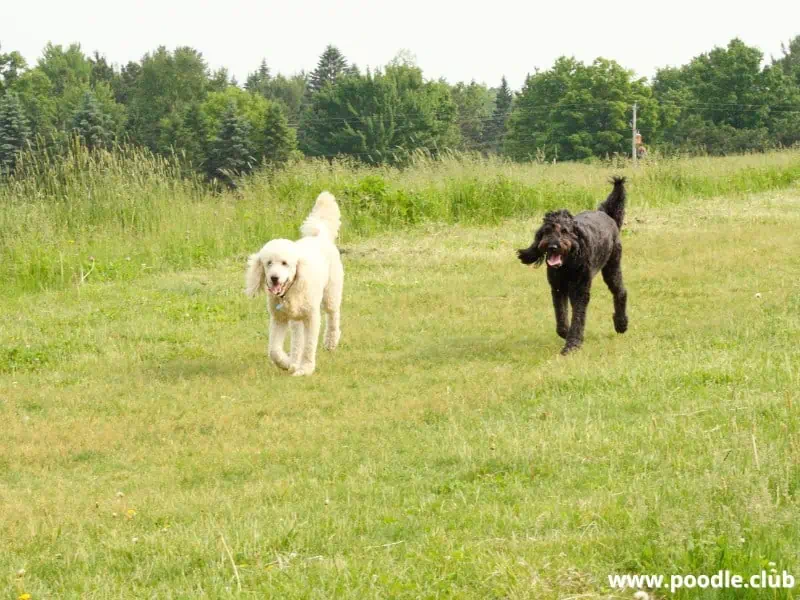Can You Run with a Labradoodle? A Quick Guide for Active Owners
Running with your dog by your side can be a rewarding and enjoyable bonding experience. For those with a Labradoodle, you might be wondering if this breed is an ideal running partner. Labradoodles are a popular hybrid breed, combining the friendly and intelligent Poodle with the active and loyal Labrador Retriever.
This makes them not only great family pets but also potential running mates.

Before hitting the pavement together, it’s important to understand your Labradoodle’s exercise needs and abilities. Just like humans, each dog is unique and has its own limits and preferences. Generally, Labradoodles are known for their energetic and athletic nature, but it’s crucial to consider their age, current fitness level, and any health concerns before embarking on a running regimen.
To ensure the best experience for you and your Labradoodle, proper preparation and training are essential. Start by introducing your dog to the idea of running by going on gradual increases in distance and speed. This process will help your dog adjust to the activity and build endurance while strengthening the bond between both of you.
Key Takeaways
- Labradoodles have the potential to be great running partners due to their energetic and athletic nature.
- Consider your dog’s age, fitness level, and health concerns before starting a running regimen.
- Gradually introduce running by increasing distance and speed, ensuring proper preparation and training for your Labradoodle.
Understanding Labradoodles
Labradoodles are a popular breed, resulting from a mix between a Poodle and a Labrador Retriever. They come in different sizes, such as Standard Labradoodle, Miniature Labradoodle, and Toy Labradoodle, depending on the size of the Poodle parent. In this section, you will gain an understanding of Labradoodles and their suitability for running.

Labradoodles inherit traits from both Poodles and Labrador Retrievers. Poodles are known for their intelligence and agility, while Labrador Retrievers are known for their friendliness and athletic abilities. This combination makes Labradoodles an adaptable and active breed, capable of participating in various activities.
Labradoodle puppies, like all puppies, have a high energy level and require regular exercise as they grow. Therefore, it’s important to gradually introduce them to running and other activities. As they mature, their stamina and endurance improve, making them more suitable for running longer distances.
Here’s an overview of the different Labradoodle sizes:
- Standard Labradoodles: Can grow up to 24 inches tall and weigh between 45-100 pounds.
- Miniature Labradoodles: Can reach a height of 14-24 inches and weigh between 15-65 pounds.
- Toy Labradoodles: Generally smaller than 14 inches tall and weigh between 4-15 pounds.
It is worth noting that the size of your Labradoodle may affect its running capabilities. Standard Labradoodles are generally better suited for long-distance running due to their larger size and higher stamina. On the other hand, Toy Labradoodles might not be the best running companions due to their small size and limited endurance.
In conclusion, Labradoodles are a versatile and energetic breed that can be great running companions, depending on their size and individual characteristics. Start training them gradually and keep a close eye on their response to different activities. This will ensure a fun and healthy running experience for both you and your Labradoodle.
Exercise Needs of a Labradoodle

Puppy Stage
During the puppy stage, it’s essential to remember that Labradoodle puppies are still developing. Their bones and joints are growing, so over-exercising at this stage may cause harm. You should focus on socialization and short, gentle walks to begin their exercise journey.
Playing fetch and participating in age-appropriate training sessions will contribute to their overall fitness and well-being.
PuppySpot is a reputable dog marketplace where you can browse and find compatible puppies right from the comfort of your home. They have placed over 200,000 puppies into homes in the US!
Adulthood
As your Labradoodle reaches adulthood, their exercise needs increase. They are an energetic and athletic breed, so it’s crucial to keep them fit and engaged. A healthy adult Labradoodle can make a fantastic running partner.
You can gradually increase the pace, speed, and distance of their runs as they grow more comfortable and conditioned. Remember to alternate your running routine with other forms of physical activity, such as:
- Swimming
- Fetch
- Agility training
During this stage, regular jogging and walking sessions help maintain your Labradoodle’s athleticism while providing mental stimulation. Ensure your dog has proper rest periods between exercise sessions to prevent overexertion.
Senior Stage
When your Labradoodle reaches its senior stage, their exercise needs may change. Mobility issues are common in older dogs, and their pace may decrease. Adjust your exercise plan accordingly, focusing more on low-impact activities such as:
- Leisurely walks
- Gentle swimming sessions
- Light playtime
Always monitor your senior Labradoodle for signs of discomfort or pain during exercise, and consult with a veterinarian if you have concerns about their health or mobility. Remember, staying active is essential for their overall well-being, even as they age.
Preparing for a Run with Your Labradoodle

Health Check
Before you head out for a run with your Labradoodle, it’s important to ensure they are in good health. Consult your vet to determine if your dog is fully-grown, typically around 12-18 months of age. This is crucial since their bones and joints are not fully developed before this stage, increasing the risk of injuries.
Keep track of your Labradoodle’s weight to avoid any issues related to obesity or joint stress. Consider the weather and temperature when planning a run. Avoid running in excessive heat or cold, as this may harm your dog.
Furthermore, be mindful of the terrain to ensure your Labradoodle’s safety.
Running Preparations
Before running, make sure you have the following items:
- A running leash: It’s best to use a running leash that attaches to your waist, ensuring your hands are free and providing better control.
- Water and a water bowl: Hydration is essential for both you and your dog, so carry enough water for both.
- A first aid kit: Prepare for potential injuries by having a first aid kit on hand.
Gradually increase the pace and duration of your runs. Start by jogging for 5 minutes, then work your way up to 20 or 30 minutes as your Labradoodle adapts to the exercise. Adjust your speed according to your dog’s pace, avoiding the urge to sprint.
Precautions are key when running with your Labradoodle. Monitor their behavior and comfort throughout the run, and make adjustments as necessary to ensure an enjoyable experience for both you and your furry jogging partner.
Training Your Labradoodle for Runs

Basic Obedience
Before you start training your Labradoodle for runs, it’s important to establish basic obedience. This will create a solid foundation and ensure both you and your dog have a successful and enjoyable running experience. Teach your Labradoodle essential commands such as “sit,” “stay,” “come,” and “heel.”
These commands will help manage distractions and keep your dog safe while running.
Begin training sessions when your Labradoodle is still a puppy, as they tend to be more receptive to learning. Be consistent and patient, and use positive reinforcement to reward good behavior.
Specific Exercise Regimen
Start by introducing your Labradoodle to activities like walking and light jogging. Make sure to gradually increase the duration and intensity of each session. For instance, you can begin with a 5-minute walk, progressively working up to a 20-minute jog over a few weeks.
During the exercise sessions, incorporate playful activities such as fetch to keep your Labradoodle engaged and to improve their physical stamina. Remember to be mindful of your dog’s limits, and consistently monitor their response to the exercise regimen.
Appropriate Diet
A balanced diet is essential for your Labradoodle’s overall health, well-being, and exercise routine. Ensure that your dog consumes high-quality, nutritious dog food that meets their specific dietary requirements. Regularly provide fresh water in a clean water bowl, especially during and after runs.
As your Labradoodle’s exercise levels increase, they may require additional calories. Consult your veterinarian for guidance on adjusting your dog’s diet to suit their new running activity. Remember to maintain a healthy balance and avoid overfeeding or underfeeding your dog.
In conclusion, by focusing on basic obedience, specific exercise routines, and an appropriate diet, you can successfully train your Labradoodle to become a fantastic running partner.
Conclusion
Labradoodles make excellent running partners for dog owners who love to jog or sprint. As a mix between a Poodle and a Labrador Retriever, they inherit athleticism and energy from both breeds. Make sure to consult your veterinarian before beginning a running regime with your Labradoodle, as they can advise on the best training methods, joint health, and exercise duration.
You’ll notice that Labradoodles thoroughly enjoy running, making them a great motivational partner for you. However, be mindful of their age, weight, and overall health when engaging in physical activities with them. Always keep a close watch on puppies, as too much running at a young age can lead to joint or mobility issues.
When running with your Labradoodle, consider different surfaces like grass and asphalt, as well as weather conditions. Alternate between jogging, playing fetch, and sprinting, for 20-30 minute sessions. This will provide your Labradoodle with a variety of exercises to maintain their fitness and mental stimulation.
Remember to always walk before running with your dog to allow for proper warm-up and stretch their muscles. It’s important to monitor your dog’s paws, joints, and bones during runs and monitor their dog food intake to ensure they have the energy required for these activities.
Safety is essential, so consider using a leash and proper obedience training to prevent distractions or potential injuries. Additionally, having a first aid kit handy during your runs is a good precaution.
Socialization and bonding are crucial between you and your Labradoodle, so find activities that you both enjoy, like a leisurely walk or playing fetch. With patience, training, and some supervision from your vet, your Labradoodle can become the perfect running partner.



![When Do Poodles Shed Their Puppy Coat? [Age Guide]](https://poodle.club/wp-content/uploads/2022/05/when-do-poodles-shed-their-puppy-coat-768x512.webp)


![Toy vs Miniature Poodle [Comparison + Photos]](https://poodle.club/wp-content/uploads/2022/12/toy-vs-mini-poodle-768x512.webp)
